Wrinkle-Shaped Nickel Sulfide Grown on Three-Dimensional Nickel Foam: A Binder-Free Electrode Designed for High-Performance Electrochemical Supercapacitor Applications
Abstract
:1. Introduction
2. Experimental Procedure
2.1. Materials
2.2. Methods
2.3. Electrochemical Measurements
2.4. Fabrication of the w-NiS-3D-Nf and NiS-3D-Nf
3. Results and Discussion
3.1. XRD Analysis
3.2. SEM Analysis
3.3. XPS Analysis
3.4. Electrochemical Analysis
4. Conclusions
Author Contributions
Funding
Institutional Review Board Statement
Informed Consent Statement
Data Availability Statement
Acknowledgments
Conflicts of Interest
References
- Parveen, N.; Ansari, S.A.; Ansari, M.Z.; Ansari, M.O. Manganese oxide as an effective electrode material for energy storage: A review. Environ. Chem. Lett. 2022, 20, 283–309. [Google Scholar] [CrossRef]
- Ansari, M.Z.; Parveen, N.; Nandi, D.K.; Ramesh, R.; Ansari, S.A.; Cheon, T.; Kim, S.H. Enhanced activity of highly conformal and layered tin sulfide (SnSx) prepared by atomic layer deposition (ALD) on 3D metal scaffold towards high performance supercapacitor electrode. Sci. Rep. 2019, 9, 10225. [Google Scholar] [CrossRef] [PubMed]
- Ansari, M.Z.; Nandi, D.K.; Janicek, P.; Ansari, S.A.; Ramesh, R.; Cheon, T.; Shong, B.; Kim, S.-H. Low-temperature atomic layer deposition of highly conformal tin nitride thin films for energy storage devices. ACS Appl. Mater. Interfaces 2019, 11, 43608–43621. [Google Scholar] [CrossRef] [PubMed]
- Yu, M.; Chen, J.; Liu, J.; Li, S.; Ma, Y.; Zhang, J.; An, J. Mesoporous NiCo2O4 nanoneedles grown on 3D graphene-nickel foam for supercapacitor and methanol electro-oxidation. Electrochim. Acta 2015, 151, 99–108. [Google Scholar] [CrossRef]
- Liu, L.; Zhao, H.; Lei, Y. Advances on three-dimensional electrodes for micro-supercapacitors: A mini-review. InfoMat 2019, 1, 74–84. [Google Scholar] [CrossRef] [Green Version]
- Faraji, S.; Ani, F.N. Microwave-assisted synthesis of metal oxide/hydroxide composite electrodes for high power supercapacitors—A review. J. Power Sources 2014, 263, 338–360. [Google Scholar] [CrossRef]
- Shaikh, S.; Rabinal, M.K. Facile one-step growth of nickel sulfide nano-architecture as binder less electrodes for efficient supercapacitor applications. Mater. Sci. Semicond. Processing 2022, 142, 106524. [Google Scholar] [CrossRef]
- Yu, L.; Yang, B.; Liu, Q.; Liu, J.; Wang, X.; Song, D.; Wang, J.; Jing, X. Interconnected NiS nanosheets supported by nickel foam: Soaking fabrication and supercapacitors application. J. Electroanal. Chem. 2015, 739, 156–163. [Google Scholar] [CrossRef]
- Ho, K.; Lin, L. A review of electrode materials based on core–shell nanostructures for electrochemical supercapacitors. J. Mater. Chem. A 2019, 7, 3516–3530. [Google Scholar] [CrossRef]
- Khalid, S.; Khan, Y.; Ahmed, E.; Nawaz, S.; Khalid, N.R.; Ahmed, W. Chapter 16—Transition metal sulfides for supercapacitors. In Micro and Nano Technologies, Emerging Nanotechnologies for Renewable Energy; Ahmed, W., Booth, M., Nourafkan, E., Eds.; Elsevier: Amsterdam, The Netherlands, 2021; pp. 407–445. [Google Scholar]
- Akhtar, M.S.; Gul, I.H.; Baig, M.M.; Akram, M.A. Binder-free pseudocapacitive nickel cobalt sulfide/MWCNTs hybrid electrode directly grown on nickel foam for high rate supercapacitors. Mater. Sci. Eng. B 2021, 264, 114898. [Google Scholar] [CrossRef]
- Parveen, N.; Ansari, S.A.; Ansari, S.G.; Fouad, H.; Salam, N.M.; Cho, M.H. Solid-state symmetrical supercapacitor based on hierarchical flower-like nickel sulfide with shape-controlled morphological evolution. Electrochim. Acta 2018, 268, 82–93. [Google Scholar] [CrossRef]
- Ansari, S.A.; Parveen, N.; Alothoum, M.A.S.; Ansari, M.O. Development of binder free interconnected 3D flower of NiZn2O4 as an advanced electrode materials for supercapacitor Applications. Crystals 2022, 12, 14. [Google Scholar] [CrossRef]
- Liu, B.; Zhang, J.; Wang, X.; Chen, G.; Chen, D.; Zhou, C.; Shen, G. Hierarchical Three-Dimensional ZnCo2O4 Nanowire Arrays/Carbon Cloth Anodes for a Novel Class of High-Performance Flexible Lithium-Ion Batteries. Nano Lett. 2012, 12, 3005–3011. [Google Scholar] [CrossRef] [PubMed]
- Zhang, G.Q.; Wu, H.B.; Hoster, H.E.; Chan-Park, M.B.; Lou, X.W. Single-crystalline NiCo2O4 nanoneedle arrays grown on conductive substrates as binder-free electrodes for high-performance supercapacitors. Energy Environ. Sci. 2012, 5, 9453–9456. [Google Scholar] [CrossRef]
- Rahman, M.A.; Rahman, M.M.; Song, G. A review on binder-free NiO-Ni foam as anode of high performance lithium-ion batteries. Energy Storage 2021, e278, in press. [Google Scholar] [CrossRef]
- Noémie, E.; Rountree, K.J.; McCarthy, B.D.; Rountree, E.S.; Eisenhart, T.T.; Dempsey, J.L. A practical beginner’s guide to cyclic voltammetry. J. Chem. Educ. 2018, 95, 197–206. [Google Scholar]
- Stoller, M.D.; Ruoff, R.S. Best practice methods for determining an electrode material’s performance for ultracapacitors. Energy Environ. Sci. 2010, 3, 1294–1301. [Google Scholar] [CrossRef]
- Aderyani, S.; Flouda, P.; Shah, S.A.; Green, M.J.; Lutkenhaus, J.L.; Ardebili, H. Simulation of cyclic voltammetry in structural supercapacitors with pseudocapacitance behavior. Electrochim. Acta 2021, 390, 138822. [Google Scholar] [CrossRef]
- Ouyang, Y.; Chen, Y.; Peng, J.; Yang, J.; Wu, C.; Chang, B.; Guo, X.; Chen, G.; Luo, Z.; Wang, X. Nickel sulfide/activated carbon nanotubes nanocomposites as advanced electrode of high-performance aqueous asymmetric supercapacitors. J. Alloys Compd. 2021, 885, 160979. [Google Scholar] [CrossRef]
- Niu, W.; Xiao, Z.; Wang, S.; Zhai, S.; Qin, L.; Zhao, Z.; An, Q. Synthesis of nickel sulfide-supported on porous carbon from a natural seaweed-derived polysaccharide for high-performance supercapacitors. J. Alloys Compd. 2021, 853, 157123. [Google Scholar] [CrossRef]
- Li, X.; Yan, W.; Guo, S.; Liu, Y.; Niu, J.; Yin, L.; Wang, Z. One-step electrochemical controllable preparation of nickel cobalt sulfide nanosheets and its application in supercapacitors. Electrochim. Acta 2021, 387, 138488. [Google Scholar] [CrossRef]
- Hu, Q.; Zhang, S.; Zou, X.; Hao, J.; Bai, Y.; Yan, L.; Li, W. Coordination agent-dominated phase control of nickel sulfide for high-performance hybrid supercapacitor. J. Colloid Interface Sci. 2022, 607, 45–52. [Google Scholar] [CrossRef] [PubMed]
- Iqbal, M.F.; Yousef, A.K.M.; Hassan, A.; Hussain, S.; Ashiq, M.N.; Razaq, A. Significantly improved electrochemical characteristics of nickel sulfide nanoplates using graphene oxide thin film for supercapacitor applications. J. Energy Storage 2021, 33, 102091. [Google Scholar] [CrossRef]
- Peng, L.; Ji, X.; Wan, H.; Ruan, Y.; Xu, K.; Chen, C.; Miao, L.; Jiang, J. Nickel sulfide nanoparticles synthesized by microwave-assisted method as promising supercapacitor electrodes: An experimental and computational study. Electrochim. Acta 2015, 182, 361–367. [Google Scholar] [CrossRef]
- Naveenkumar, P.; Kalaignan, G.P. Electrodeposited MnS on graphene wrapped Ni-Foam for enhanced supercapacitor applications. Electrochim. Acta 2018, 289, 437–447. [Google Scholar] [CrossRef]
- Marand, N.A.; Masoudpanah, S.M.; Alamolhoda, S.; Bafghi, M.S. Solution combustion synthesis of nickel sulfide/reduced graphene oxide composite powders as electrode materials for high-performance supercapacitors. J. Energy Storage 2021, 39, 102637. [Google Scholar] [CrossRef]
- Huang, H.; Deng, X.; Yan, L.; Wei, G.; Zhou, W.; Liang, X.; Guo, J. One-step synthesis of self-supported Ni3S2/NiS composite film on Ni foam by electrodeposition for high-performance supercapacitors. Nanomaterials 2019, 9, 1718. [Google Scholar] [CrossRef] [Green Version]
- Kumar, M.; Jeong, D.I.; Sarwar, N.; Yoon, D.H. Heazlewoodite, Ni3S2: An electroactive material for supercapacitor application. Ceram. Int. 2021, 47, 16852–16860. [Google Scholar] [CrossRef]
- El-Gendy, D.M.; Afifi, I.M.; Allam, N.K. Eco-friendly, one-step synthesis of cobalt sulfide-decorated functionalized graphene for high-performance supercapacitors. J. Energy Storage 2019, 24, 100760. [Google Scholar] [CrossRef]
- Wang, F.; Li, G.; Zheng, J.; Ma, J.; Yang, C.; Wang, Q. Microwave synthesis of three-dimensional nickel cobalt sulfide nanosheets grown on nickel foam for high-performance asymmetric supercapacitors. J. Colloid Interface Sci. 2018, 516, 48–56. [Google Scholar] [CrossRef]
- Saddique, J.; Cheng, X.; Shi, H.; Wu, R.; Zhang, Y. High-performance Ni-Co sulfide nanosheet-nanotubes grown on Ni Foam as a binder free electrode for supercapacitors. Appl. Sci. 2019, 9, 3082. [Google Scholar] [CrossRef] [Green Version]
- Mun, C.-H.; Gopi, C.V.V.M.; Vinodh, R.; Sambasivam, S.; Obaidat, I.M.; Kim, H.J. Microflower-like nickel sulfide-lead sulfide hierarchical composites as binder-free electrodes for high-performance supercapacitors. J. Energy Storage 2019, 26, 100925. [Google Scholar] [CrossRef]
- Gou, J.; Xie, S.; Li, Y.; Kong, X.; Li, C. Studies on preparation and performance of nickel sulfides for the application in supercapacitors. J. Mater. Sci. Mater. Electron. 2019, 30, 15429–15436. [Google Scholar] [CrossRef]
- Li, Y.; Ye, K.; Cheng, K.; Yin, J.; Cao, D.; Wang, G. Electrodeposition of nickel sulfide on graphene-covered make-up cotton as a flexible electrode material for high-performance supercapacitors. J. Power Sources 2015, 274, 943–950. [Google Scholar] [CrossRef]
- Xue, G.; Bai, T.; Wang, W.; Wang, S.; Ye, M. Recent advances in various applications of nickel cobalt sulfide-based materials. J. Mater. Chem. A 2022, 10, 8087–8106. [Google Scholar] [CrossRef]
- Singh, A.; Roberts, A.J.; Slade, R.C.T.; Chandra, A. High electrochemical performance in asymmetric supercapacitors using MWCNT/nickel sulfide composite and graphene nanoplatelets as electrodes. J. Mater. Chem. A 2014, 2, 16723–16730. [Google Scholar] [CrossRef]
- Bhagwan, J.; Hussain, S.K.; Krishna, B.N.V.; Yu, J.S. β-NiS 3D micro-flower-based electrode for aqueous asymmetric supercapacitors. Sustain. Energy Fuels 2020, 4, 5550–5559. [Google Scholar] [CrossRef]
- Darsara, S.A.; Seifi, M.; Askari, M.B.; Osquian, M. Hierarchical 3D starfish-like Ni3S4–NiS on reduced graphene oxide for high-performance supercapacitors. Ceram. Int. 2021, 47, 20992–20998. [Google Scholar] [CrossRef]
- Ahmed, N.; Ali, B.A.; Ramadan, M.; Allam, N.K. Three-dimensional interconnected binder-free Mn–Ni–S nanosheets for high performance asymmetric supercapacitor devices with exceptional cyclic stability. ACS Appl. Energy Mater. 2019, 2, 3717–3725. [Google Scholar] [CrossRef]
- Paliwal, M.K.; Meher, S.K. Co3O4/NiCo2O4 perforated nanosheets for high-energy-density all-solid-state asymmetric supercapacitors with extended cyclic stability. ACS Appl. Nano Mater. 2020, 3, 4241–4252. [Google Scholar] [CrossRef]
- Hu, Q.; Li, W.; Xiang, B.; Zou, X.; Hao, J.; Deng, M.; Wu, Q.; Wang, Y. Sulfur source-inspired synthesis of β-NiS with high specific capacity and tunable morphologies for hybrid supercapacitor. Electrochim. Acta 2020, 337, 135826. [Google Scholar] [CrossRef]
- Chen, L.; Guan, L.; Tao, J. Morphology control of Ni3S2 multiple structures and their effect on supercapacitor performances. J. Mater. Sci. 2019, 54, 12737–12746. [Google Scholar] [CrossRef]

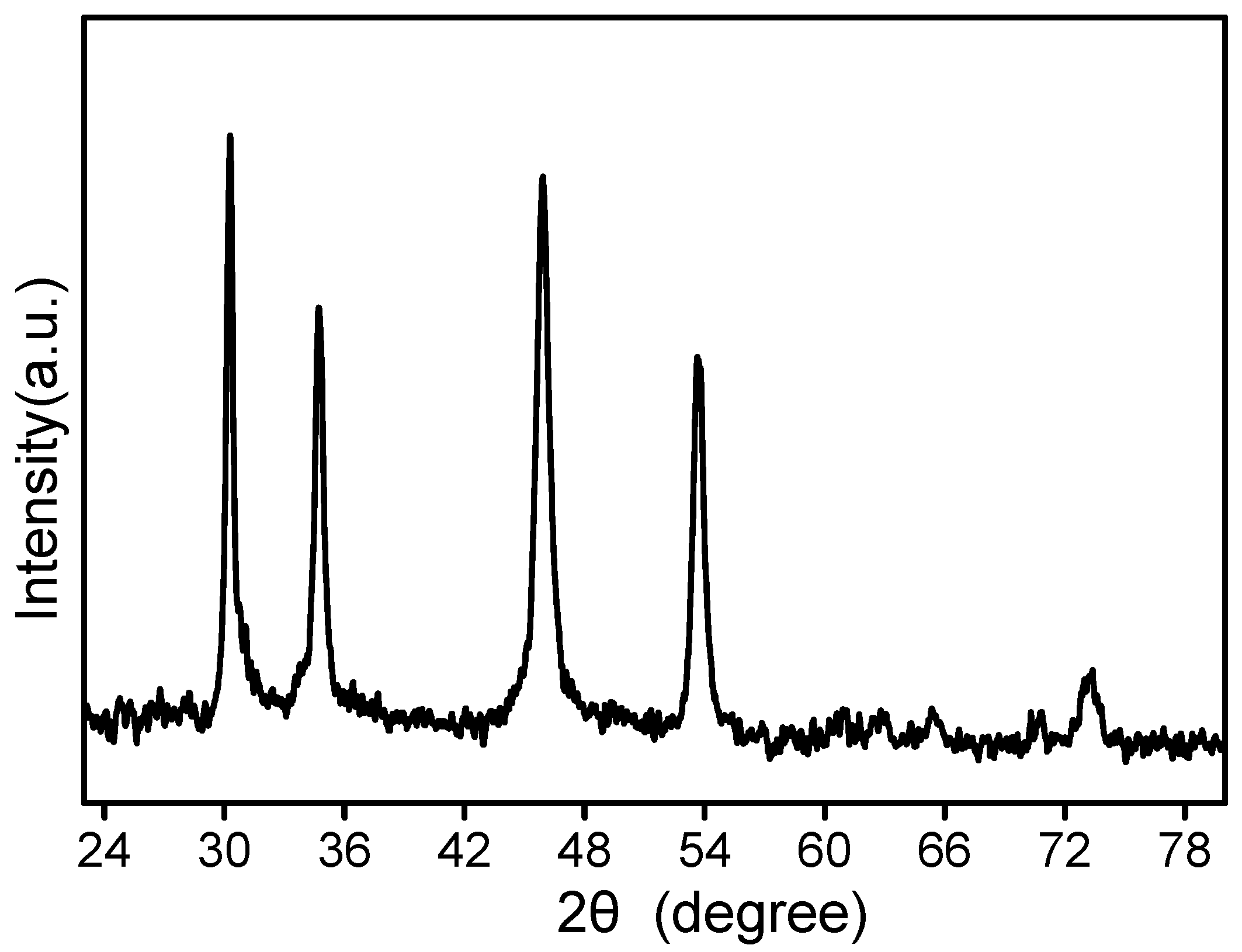
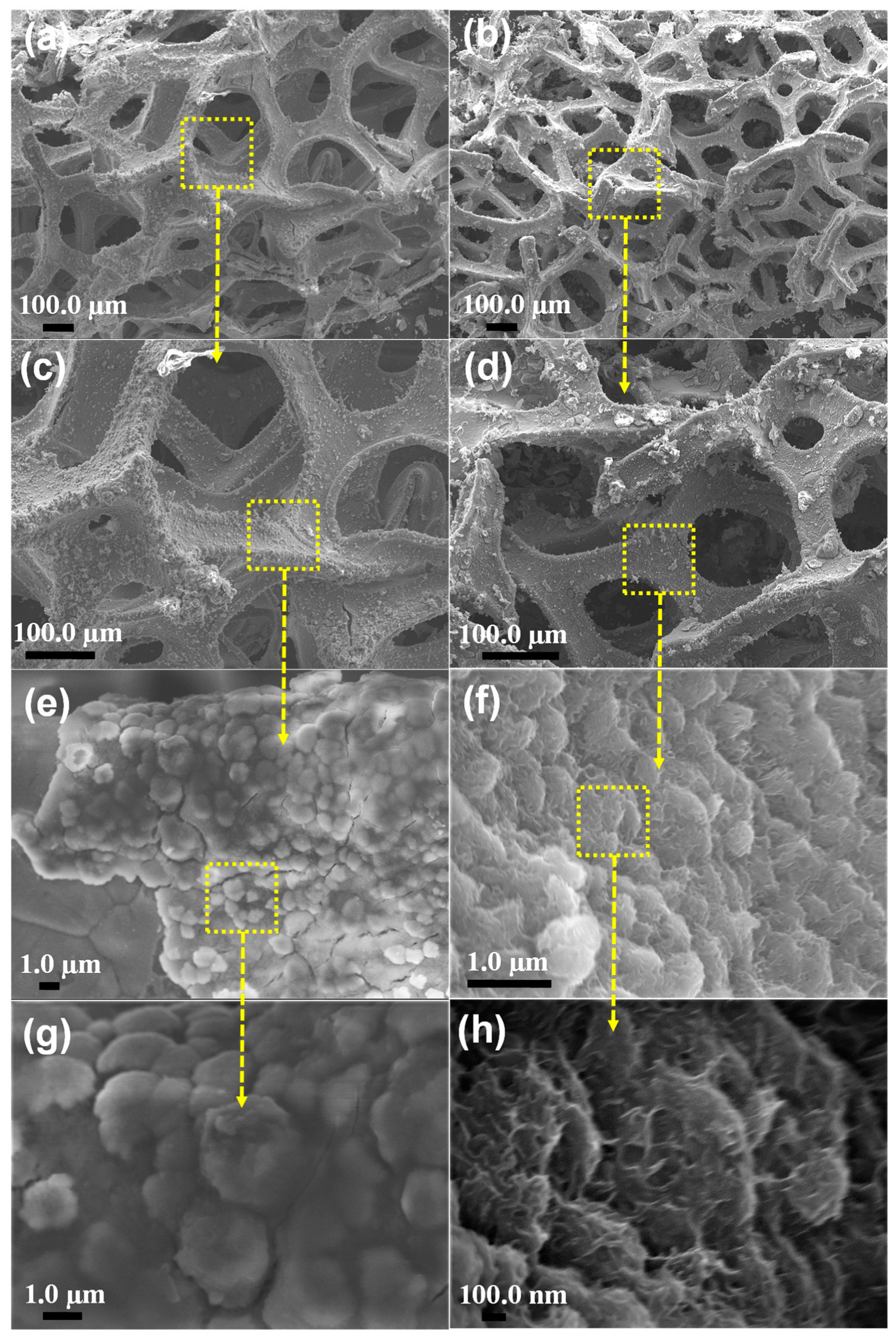
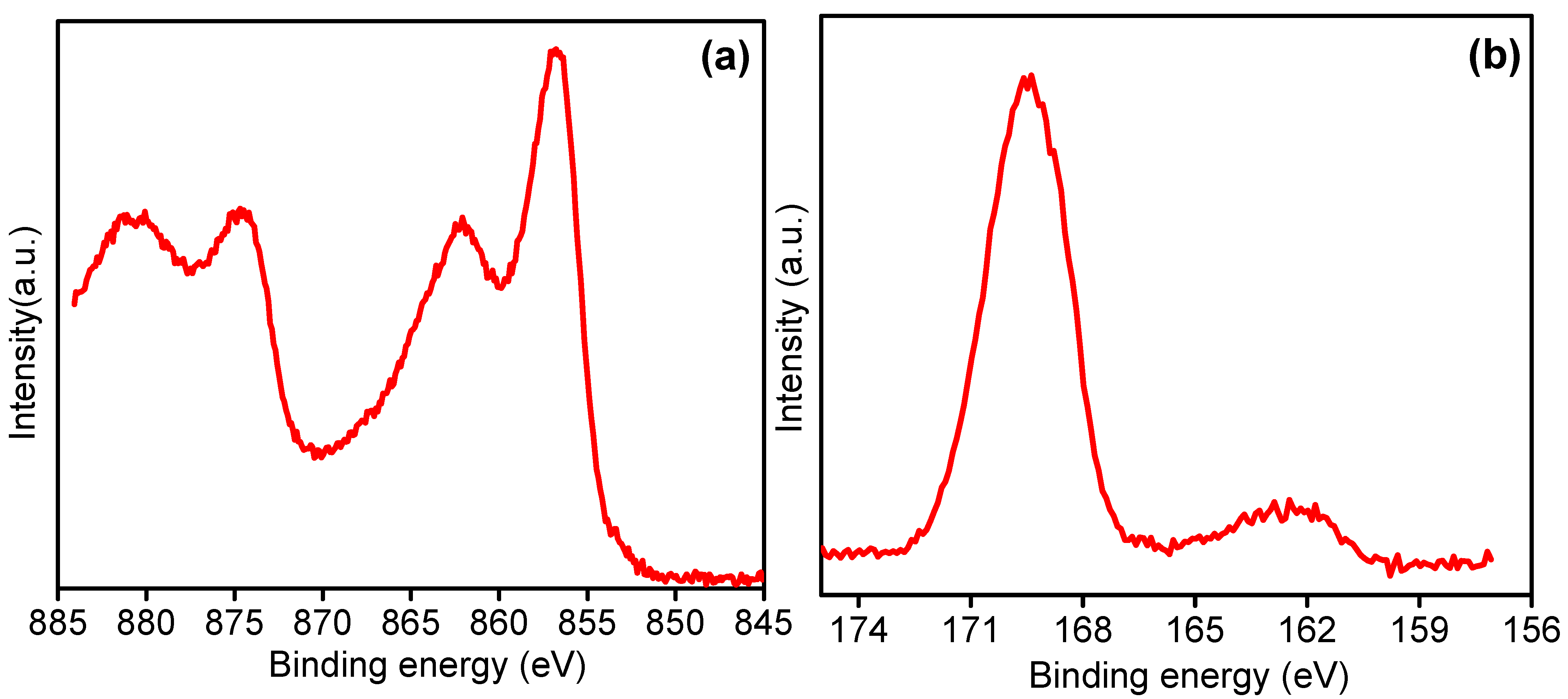
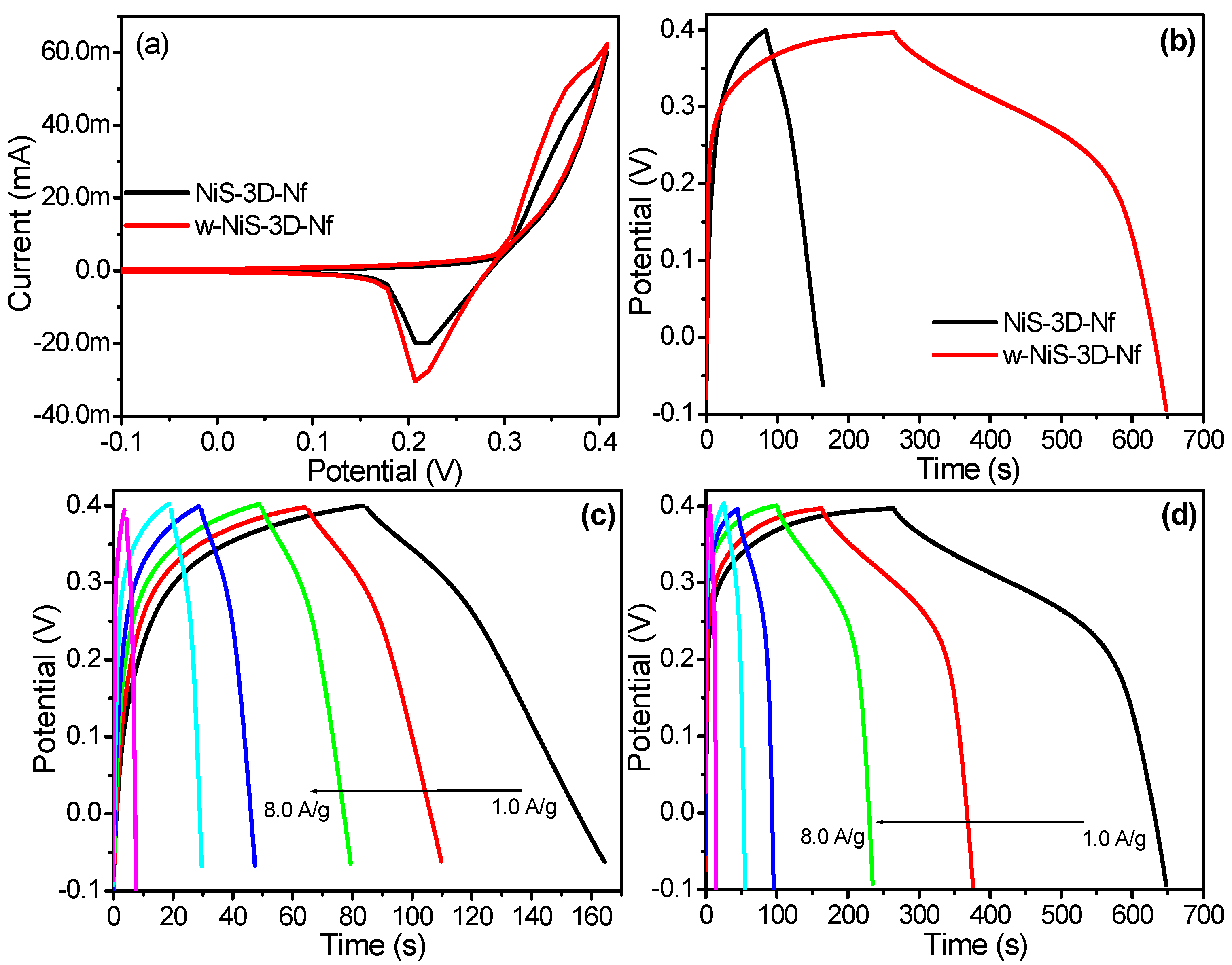
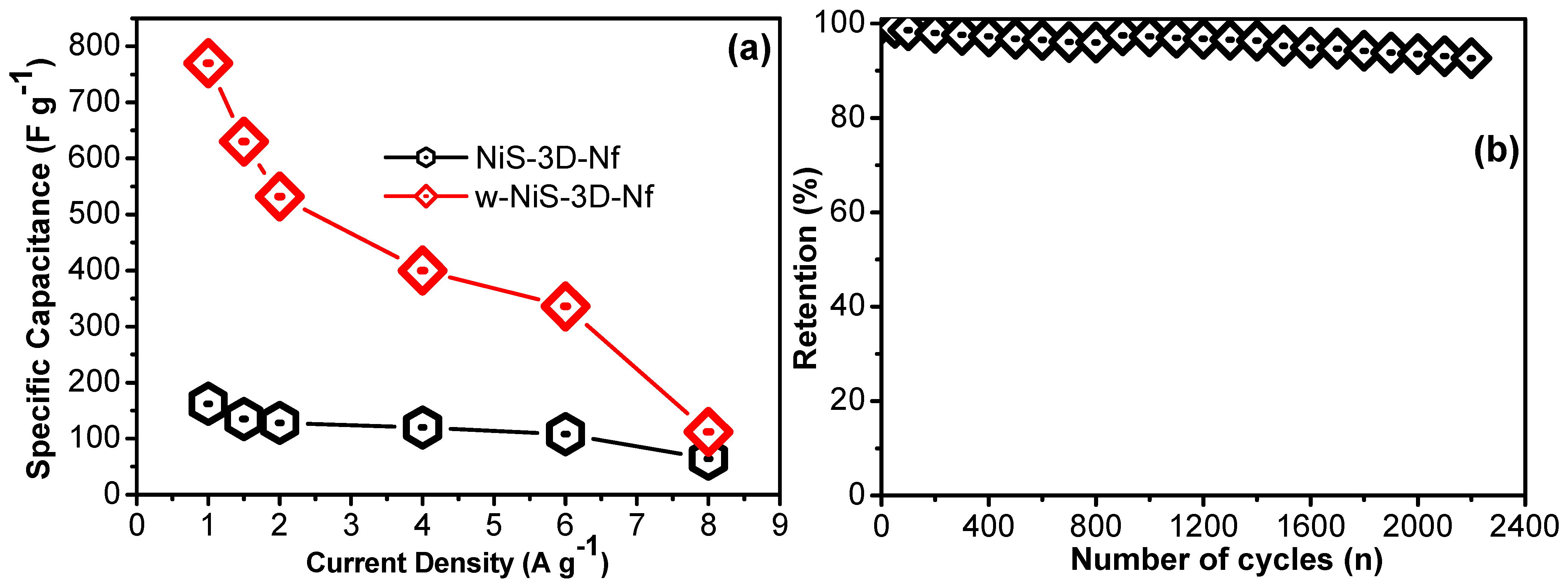
Publisher’s Note: MDPI stays neutral with regard to jurisdictional claims in published maps and institutional affiliations. |
© 2022 by the authors. Licensee MDPI, Basel, Switzerland. This article is an open access article distributed under the terms and conditions of the Creative Commons Attribution (CC BY) license (https://creativecommons.org/licenses/by/4.0/).
Share and Cite
Ansari, S.A.; Kotb, H.M.; Ahmad, M.M. Wrinkle-Shaped Nickel Sulfide Grown on Three-Dimensional Nickel Foam: A Binder-Free Electrode Designed for High-Performance Electrochemical Supercapacitor Applications. Crystals 2022, 12, 757. https://doi.org/10.3390/cryst12060757
Ansari SA, Kotb HM, Ahmad MM. Wrinkle-Shaped Nickel Sulfide Grown on Three-Dimensional Nickel Foam: A Binder-Free Electrode Designed for High-Performance Electrochemical Supercapacitor Applications. Crystals. 2022; 12(6):757. https://doi.org/10.3390/cryst12060757
Chicago/Turabian StyleAnsari, Sajid Ali, Hicham Mahfoz Kotb, and Mohamad M. Ahmad. 2022. "Wrinkle-Shaped Nickel Sulfide Grown on Three-Dimensional Nickel Foam: A Binder-Free Electrode Designed for High-Performance Electrochemical Supercapacitor Applications" Crystals 12, no. 6: 757. https://doi.org/10.3390/cryst12060757
APA StyleAnsari, S. A., Kotb, H. M., & Ahmad, M. M. (2022). Wrinkle-Shaped Nickel Sulfide Grown on Three-Dimensional Nickel Foam: A Binder-Free Electrode Designed for High-Performance Electrochemical Supercapacitor Applications. Crystals, 12(6), 757. https://doi.org/10.3390/cryst12060757






